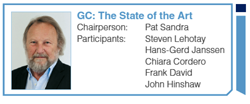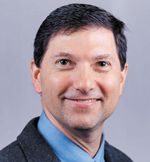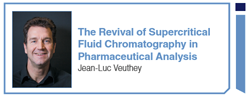GC: The State of the Art
LCGC Europe
In this extended special feature to celebrate the 30th anniversary edition of LCGC Europe, leading figures from the separation science community explore contemporary trends in separation science and identify possible future developments. We asked key opinion leaders in the field to discuss the current state of the art in gas chromatography instruments.

In this extended special feature to celebrate the 30th anniversary edition of LCGC Europe, leading figures from the separation science community explore contemporary trends in separation science and identify possible future developments. We asked key opinion leaders in the field to discuss the current state of the art in liquid chromatography column technology, gas chromatography, sample preparation, and liquid chromatography instruments. They also describe the latest practical developments in supercritical fluid chromatography, 3D printing, capillary electrophoresis, data handling, comprehensive twoâdimensional liquid chromatography, and multidimensional gas chromatography.Compiled by Alasdair Matheson, Editor-in-Chief, LCGC Europe
Pat Sandra: Do you expect that other column formats can replace fused-silica capillaries for separations based on partitioning mechanisms for gas chromatography (GC)?
Steven Lehotay: Well, it’s not technically GC, but perhaps supercritical fluid chromatography (SFC) will be used in the future to displace some of the current GC applications, which can also incorporate liquid chromatography (LC)-amenable analytes in the same method. Packed and monolithic columns for LC are more commonly used in SFC than capillary GC-type columns. SFC has been a “promising” approach for more than 25 years to broaden the analytical scope of separations, but recent improvements in mass spectrometry (MS) technology may finally make the promises of SFC a reality. Takeshi Bamba et al. have published many studies demonstrating the improved performance capabilities of modern SFC–MS.
Hans-Gerd Janssen: Open-tubular fused-silica capillaries have such marvellous efficiencies and inertness that it is hard to imagine they will ever become obsolete. But their surroundings will change. We will, for example, use different heating methods, apply time- and place-dependent temperature programmes, trap compounds, and send compounds back and forth between columns.
Chiara Cordero: Fused-silica capillaries will always play a pivotal role in GC. However, in our laboratory we recently worked with microfabricated planar columns (also known as MEMS columns) coated with conventional and enantioselective stationary phases for lab-on-a-chip GC and in-field applications. Results are promising and could open new perspectives for measurement systems supporting at-line quality and authenticity controls with portable systems. This is already true for other application areas, for example, in the petrochemical sector, where micro-GC systems are routinely adopted for process control.
The global market in the field of flavours and fragrances requires high-standard quality controls at each critical stage: International companies are intrigued by the possibility of at-line and on-line quality controls, which drives the impulse to develop portable solutions.
Frank David: In my opinion no other column format can meet the quality of fused-silica capillary GC columns. In general, the standard fused-silica GC columns have good inertness, efficiency, low bleed, and can be produced with very high reproducibility. Even vendorâtoâvendor variability is low. I believe that this format will remain the standard for the next decades. A new GC system was recently introduced with a lot of chip technology incorporated, but the classical fused-silica column format is maintained. Chip-based columns for micro-GC systems are typically used for permanent gas analysis and produce sufficient resolution and solute capacity.
John Hinshaw: In certain areas, yes. Shorter column lengths up to around 5 m can be accommodated in micromachined structures, heated directly by conduction, but for the bulk of open-tubular partition GC separations, fused silica will remain the material of choice.
Pat Sandra: In recent years, new and unique stationary phase chemistries were introduced. Have some of them been implemented in your daily routine work?
Steven Lehotay: As a result of the added selectivity in detection provided by modern MS techniques, separations are less important, and I now almost exclusively use the standard 5% phenyl, 95% methyl polysiloxane stationary phase. Analysis of nitrosamines was an exception, but tandem MS/MS for targeted analytes affords greater speed of analyses, even for isobaric analyte peaks that are not fully resolved chromatographically.
Frank David: In our laboratory, over 80% of GC applications are performed with MS detection. Consequently, the most important criteria for column selection are efficiency (sharp peaks, high peak capacity); low bleed (MS sensitivity); and high inertness (no tailing, no adsorption). The role of column selectivity is therefore less important, except in some specific cases for isomer resolution, for example, some polycyclic aromatic hydrocarbons (PAHs), and polychlorinated biphenyls (PCBs). Consequently, the need for other stationary phase selectivities is less important, compared to decades ago when most analyses were performed in combination with flame ionization detection (FID), electron capture detection (ECD), nitrogen–phosphorus detection (NPD) and other detectors, and where the chromatographic resolution was most important.
Hans-Gerd Janssen: For those of us in industry, reliability-immediately and in the long term-is crucial. When we inject the sample we trust we will have the result in, say, half an hour. There is no time for lengthy conditioning, or injection of samples to stabilize the column, for example. We need immediate results, reliably, and not for a few samples, but for at least 1000 injections. We also need consistent results. Even if a new column offers “more correct” data we would not adopt it if results are no longer comparable with those from the past. Finally, our retention time databases are built on certain phases, and we would not want to start gathering retention information all over again. So in our laboratory we would use new phases only if they allow us to do things we could not do before.
John Hinshaw: Ionic liquids stand out as the most significant recent development in GC stationary phases, for their reduced bleed and unique selectivity. In particular they are attractive for their potential for separating and quantifying low levels of water, replacing classical Karl-Fisher titration.
Chiara Cordero: The development of new stationary phases, particularly those dedicated to chiral separations, has been the focus of our laboratory’s research for many years. Professor Carlo Bicchi, who established research on capillary chromatography at the University of Turin, Italy, is a mentor, and has dedicated a large part of his career in this direction. A young generation of researchers can now focus on this fundamental research topic, which offers new possibilities for GC applications in many fields.
The new stationary-phase chemistries based on ionic liquids also offer new possibilities for GC. Today, when we face challenging separations in food, flavour, and fragrance applications we use a wide array of phases and select those suitable to achieve the most reliable and consistent results. A practical way to progress would be if more laboratories made retention indices databases available for most of the new stationary phases. This could be a good point of interaction with mutual benefits between academic research and column manufacturers.
Pat Sandra: We all agree that hydrogen is the best carrier gas for capillary gas chromatography (cGC). Why is it still not universally applied, even in GC–MS?
Steven Lehotay: The low viscosity of hydrogen is desirable, but not its reactivity or safety concerns. By extending the vacuum provided by MS all the way up the analytical column, the viscosity of helium is lowered, thereby providing the main benefit of hydrogen for faster optimal separations, but in this way, the carrier gas is inert. Nitrogen under vacuum can also be used as a less viscous carrier gas, but nitrogen kills sensitivity in MS with electron ionization. In 1962, J. Calvin Giddings demonstrated that low-pressure (LP) GC was advantageous, and in 2000, Jaap de Zeeuw devised a practical approach using a restriction capillary to keep the inlet pressurized as usual in GC. My colleagues and I have been successfully using the LPGC–MS(/MS) approach for more than 15 years, and I invite others to also try it in their applications.
Hans-Gerd Janssen: We run most of our GC–FIDs on hydrogen. Not the MS instruments, because of the warnings and disclaimers from manufacturers. I know of other laboratories that do not move to hydrogen because of the initial investments needed in generators and safety devices. These one-time only costs are very visible and return on investment often exceeds the industry standard of 2–4 years.
Frank David: In our laboratory, hydrogen is the standard carrier gas choice for all GC work, while helium is used for GC–MS. The restriction towards hydrogen is twofold: safety and performance. I believe that in state-of-theâart GC systems, there are sufficient safety measures, including leak detection and shutdown procedures, that the use of hydrogen as carrier gas for standard GC–FID work should not be an issue anymore.
For GC–MS work, however, there is a clear difference in performance. In general, sensitivity is about two- to fourfold lower using hydrogen compared to helium carrier gas. This is a result of a combination of higher background, in some cases “source bleeding”, and less efficient vacuum (ionization). If ultimate sensitivity is not required, hydrogen can indeed be used in combination with MS.
John Hinshaw: There are four main reasons. First, regulated laboratories (ISO, USP, US EPA) must revalidate or requalify programmed-temperature GC methods when changing the mobile phase to hydrogen because of potential shifts in relative retention of critical peak pairs (or even peak reversal) when simultaneously modifying carrier-gas velocity or flow. The effects are minimized when using the guidance of method translation software to select new flows and temperature programmes, but even so peak identities need to be verified.
Second, detector sensitivities may be affected, certainly with thermal conductivity detectors (TCD) and with FID if constant hydrogen flow is not maintained. Third, for GC–MS, there are uncertainties in electron ionization (EI) fragmentation patterns and chemical ionization (CI) reactions that might invalidate stock spectral libraries. Finally, there is still a perceived barrier to H2 carrier adoption because of hydrogen’s flammability, especially in GC–MS vacuum systems that could become hydrogen-accumulating volumes when improperly vented. These barriers can be overcome with operator training and with installation of flammable gas monitoring devices, but this makes the transition to hydrogen more difficult.
Pat Sandra: Is it correct that some very promising modes of injection developed in the 20th century, for example, cool on-column (COC) injection and large volume programmed temperature vaporizing (PTV) injection are hardly applied in the 21st century? What are the reasons?
Steven Lehotay: As Matthew Klee and others have described in detail, split injection is nearly always the best approach for injection in GC, in terms of both short- and long-term chromatographic performance. However, older MS instruments were not sensitive enough using split injection to meet limit of quantification (LOQ) needs in ultratrace analyses, unless a time-consuming concentration step was conducted during sample preparation. In those days, PTV and pressure-pulsed splitless injection were good options to introduce enough equivalent sample into the column, but state-of-the-art GC–MS(/MS) instruments are able to meet LOQ needs using split injection, and that is one reason for the reduced need for PTV now.
Hans-Gerd Janssen: Obviously these methods are more complex than a simple split or splitless injection so you would logically like to avoid more complicated methods. Implementing and operating them is not straightforward and because the necessity to do so has decreased as a result of the improved MS sensitivity you rapidly lose experience in using them, which in turn means the resistance to using them increases further. Other solutions, such as offline evaporation and LC–MS, may be a preferable alternative.
Frank David: It is correct that in most laboratories the large majority of injections in GC are performed in split or splitless mode using a “split–splitless inlet”, maintained at a constant high temperature. This is mainly because this inlet is most “forgiving” for dirty samples or improper sample preparation, including the selection of solvent, resulting in acceptable results without full optimization. On the other hand, as consultants for GC users in a wide range of industries, we also encounter lots of analytical problems that are often related to improper injection optimization.
Lack of training and slow degradation of knowledge of the fundamentals of GC are the main drivers here. In our laboratory, both COC and PTV injection are widely used, so maybe we are atypical GC users. COC is and remains the reference inlet, especially in high temperature GC. PTV is the most versatile inlet, putting less thermal stress on the sample (cold split or splitless), allowing large volume injection (solvent vent mode) and it is also used as interface (cold trap) for many sample introduction systems, such as thermal desorption, dynamic headspace, and pyrolysis.
John Hinshaw: Both these injection techniques require specialized inlets with associated settings, and possibly a retention gap. As a result of these complexities, classical split–splitless injection will be favoured unless there is a sample-driven reason, such as thermolabile or high molecular-weight compounds.
Pat Sandra: Comprehensive GC×GC has gained prominence at international meetings and in the literature in recent years. Do you expect a breakthrough in the coming years for routine analyses? Will modulation by temperature or by flow be mostly applied? Is the data handling sufficiently developed in terms of accuracy and speed for routine applications?
Steven Lehotay: GC×GC provides greater selectivity in separations, but as it is commonly used now, it adds too much time to the analysis. Another major problem is that a microbore second-dimension column is easily overwhelmed by high concentration matrix components, which is nearly always the case in real-world samples. GC×GC is overkill in common applications and fails in many difficult ones, thus, it needs to be used in a different way to provide faster separations with more sample capacity. I think a breakthrough in GC×GC would have been possible many years ago if the drivers of the technology had decided to overcome its practical limitations, including excessive liquid nitrogen usage for cryogenic modulation, rather than demonstrate niche applications.
Hans-Gerd Janssen: GC×GC is already routinely used in the mineral oil area and in the flavour and fragrance industry, simply because one-dimensional GC cannot do the job. For many other applications we are forced, by government policies or for company-internal reasons, to stick with one dimensional GC. I do not expect a dramatic breakthrough for GC×GC, but it could evolve to 10–15% of the GC market.
Frank David: GC×GC will definitely find its way to routine application, mainly in petrochemical analysis. All types of modulators can be used, but easier, user-friendly, intuitive software and data handling are needed. Moreover, the application potential of GC×GC should not be overestimated. One-dimensional GC and GC–MS are able to cover most GC-amenable applications.
Chiara Cordero: I see GC×GC growing in core application areas, including petrochemical, environmental, food and flavours, natural products, and metabolomic studies, and in my research activity I’ve met new users approaching this technique with curiosity but also with many prejudices and false convictions. My feeling is that we still are in the “induction period”.
The possibility of applying dedicated pattern recognition approaches to the analysis of 2D chromatographic data opens new perspectives for fingerprinting studies. This last aspect is a key feature of the technique and it will soon trigger the widespread use of GC×GC in many fields. As experts and passionate chromatographers we have to continue research in the direction of making this technique more intuitive and easy to use with new data analysis tools and approaches to create a “toolbox” for various applications.
John Hinshaw: Comprehensive GC×GC remains costly for routine use. Requiring a dedicated instrument system plus an operator with appropriate training and analytical skills (a PhD?) means only “high-impact” analyses will be performed this way. I see incremental improvements in GC×GC complexity and ease-of-use but no breakthroughs. Quantitative measurement in GC×GC falls short of conventional chromatography data handling, but processing speed will not be an issue as dedicated GPU computing continues to grow.
Pat Sandra: Is (multiple) heart-cutting (GC-GC) an alternative for GC×GC?
Steven Lehotay: Achieving acceptable results simply is nearly always better than using complicated methods in the attempt to achieve perfect results. The more complexities in a method, the more it can go wrong, and the less likely it will work routinely for many analytes in many matrices. I always prefer to simplify, not “complificate”.
Hans-Gerd Janssen: No, it is rather the other way around. Despite very significant progress in instrumentation for heart-cutting GC-GC the technique still is (and will always be) complex. GC×GC is much simpler and more reliable and will take away much of the need for GC-GC.
Chiara Cordero: GC-GC cannot be an alternative to GC×GC! They are both capable of expanding the potentials of 1D-GC where a single dimension is not sufficient or selective enough to solve an analytical challenge. However, one is still a multiple 1D-GC approach (that is, GC-GC) and does not require a change of mindset or skills for new users while, as already mentioned, GC×GC requires a “jump” towards new measurement concepts. Once we overcome this gap, we cannot turn back!
Frank David: Not really. Both techniques have their value and can be considered complementary. GC×GC allows sample imaging, GC-GC is more powerful for detailed analysis of interesting fractions in a sample. For example, a heart-cut on an odour zone detected after a first dimension separation is very useful to isolate, identify, and quantify the compound(s) responsible for the odour.
John Hinshaw: For those separations where a limited number of peak pairs or groups can benefit from twoâdimensional selectivity, heart-cut GC-GC is more appropriate than GC×GC.
Pat Sandra: Miniaturized sample preparation methods are best matched to the features of state-of-the-art capillary gas chromatography (cGC). Do you see new developments in this respect for GC?
Steven Lehotay: As long as the test portion analyzed accurately represents the original sample, then miniaturization often leads to higher sample throughput and reduced cost. However, robotic automation tends to go hand-in-hand with miniaturization because manual manipulations typically cause excessive bias and imprecision when using test portions smaller than 1 g. GC has always lent itself to automation using robotic autosamplers, and many automated sample preparation techniques have been commercially integrated with GC instruments. Lately, we’ve been using manual QuEChERS (quick, easy, cheap, rugged, effective, and safe) extraction of test portions larger than 1 g in batches followed by automated minicolumn solidâphase extraction (SPE) cleanup, prior to LPGC–MS/MS analysis.
Hans-Gerd Janssen: Miniaturization has long been the goal. But it should not be an end in itself. It is rather a means towards safer and cheaper procedures, solvent free and sustainable, but above all rugged and reliable. More research is needed to make many of the miniaturized methods more rugged, more reliable, and easier to automate. Solid-phase microextraction (SPME) is leading the way here. Personally, I believe that microfabricated devices have great potential.
Chiara Cordero: Let me say that I hope that instrument manufacturers will invest in the direction of developing fully automated systems capable of combining most of the miniaturized sampling solutions for GC and multidimensional (MD)-GC systems. Sample preparation devices, especially those based on sorption mechanisms, are very attractive solutions for highâthroughput analyses. Our experience in the field of flavours and fragrances tells us that miniaturization and full automation allow more data (experiments) to be collected per unit time to produce more accurate and reliable results. I think that technology is ready, and some manufacturers are offering very attractive solutions, but I still see much resistance from users to these new miniaturized systems.
Frank David: Several automated and miniaturized sample preparation methods are already available and wellâestablished. These include (dynamic) headspace, thermal desorption (TD), SPME, stir-bar sorptive extraction (SBSE), SPE, and dispersive extraction (including QuEChERs). New developments are welcome, but these should be compared to the current methods in terms of performance, robustness, and automation possibilities.
John Hinshaw: Applications for QuEChERs, SPME, in-vial derivatizations, and so on will continue to grow.
Pat Sandra: For routine applications, we can easily speed up the chromatographic analysis time by a factor of at least five by reducing the column internal diameter and length. Why is this not applied today even though such columns are commercially available?
Steven Lehotay: In routine analysis, long-term performance is the most important consideration, and in the past, too much equivalent sample often needed to be introduced into the column to meet common LOQ requirements-more than microbore columns could handle. Also, the very narrow chromatographic peaks eluting from microbore columns require fast data acquisition that few MS techniques can manage. However, state-of-the-art MS tools may be able to finally fulfil the promises of fast, microbore GC using split injections of complex sample extracts.
Hans-Gerd Janssen: There are not many GC runs that take more than 45 min so I can still do 30 samples in a day. For a lot of laboratories that is more than they need to do. Production processes are perfectly controlled so fewer analyses are needed. Doing the sample preparation, integration, and paperwork for 30 samples a day involves a lot of work. In many cases the GC separation itself is simply not the rate-determining step. The exception is in laboratories where the results are needed for a release test or for deciding on the acceptance of a batch of raw materials.
Frank David: I agree that for a lot of GC samples a run time of 30 min is acceptable. If an analyst uses 150–180 µm-i.d columns, GC run-time can be reduced to about 10 min while maintaining resolution. Additional speed-up of analysis is often not needed, except in some specific cases such as reaction monitoring or fast QC screening. Reduction of column internal diameter below 150 µm also drastically reduces solute capacity and, for samples with a wide range of constituent concentrations, either overloading or lack of sensitivity can be encountered.
John Hinshaw: There are a number of technical barriers to widespread conversion to microbore columns (dc < 0.25 mm) for increased speed of analysis: First, when keeping the phase ratio roughly constant for easier method translation, the film thickness can shrink enough to significantly affect solute capacity and reduce the available dynamic range. This also presents a greater challenge to labile compounds. Second, the small column cross-section limits injectable volume for splitless mode, and it requires narrower split injection bandwidth. Third, shifts in relative retention will occur, which need to be understood and accommodated and, finally, appropriate instrumentation is required for faster injection, ramp rates, and detection, which may incur additional costs.
Chiara Cordero: This is a very challenging question. I’m working in a laboratory where fast GC has been developed and exploited with innovative solutions, including lowâpressure short conventional columns, resistively heated columns for ultrafast GC, and chipâcolumns. These have been adopted for several studies where speed offers a competitive advantage because more samples are analyzed in the same amount of time.
We collaborated with companies that were evaluating the possibility of switching from conventional GC to fast GC in their QC control laboratories. We developed methods, we validated analyses, and we provided tools to easily translate operative parameters.
Despite all our efforts in this direction there has been a reluctance to move from conventional to fast GC in a routine control laboratory in practice. It will probably be just a matter of time before this reluctance will be broken. We are living in a world where everything has to be done faster. Chromatographers not using fast GC should ask themselves why!
Pat Sandra: How do you see the future of recently released spectroscopic detectors such as vacuum ultraviolet (VUV) and solid-phase Fourier-transform infrared spectrometry (FT-IR)?
Hans-Gerd Janssen: MS is very powerful, but it is useless for isomers and for many homologues. Fortunately, GC retention times provide a lot of information on these compounds. But for important decisions, for example, in court cases or in cases of potential food or environmental safety hazards, you would really like additional spectroscopic confirmation. This is what VUV and FT-IR can offer. Probably a more important application area for these detectors is selective class-type quantification, such as mineral group-type analysis and trans fatty acid analysis, for example.
Frank David: Mass spectrometry using benchtop mass spectrometers to high-end high resolution accurate mass systems such as QTOFs and orbitrap traps can cover the vast majority of targeted and nontargeted analysis in GC. There are, however, some niche applications where other spectroscopic detectors can give complementary information. VUV seems to be interesting for certain compound classes and isomer differentiation, and (solid-phase) FT-IR is interesting to complement MS identification by functional group information. I do not think these detectors will have great value for targeted quantitative trace analysis work, but they do offer added value in identification and confirmation. In my opinion, there is still an interesting place for good elemental detection. For some applications, including identification of unknowns, GC hyphenated to inductively coupled plasma-mass spectrometry (ICP-MS) or atomic emission detection (AED), is very powerful.
John Hinshaw: VUV offers new speciation potential for compounds that can be differentiated in the near UV. Condensed-phase gas chromatography Fourier-transform infrared spectrometry (GC–FT-IR) is renewed but not new-it was available in the 1980s. Both techniques may have some future in niche applications, but only where the cost of the additional instrument(s) can be justified.
Pat Sandra: Suppose you were an instrument manufacturer. What development would you give priority to be incorporated in the next generation of GC instruments?
Steven Lehotay: I believe the myriad of GC–supersonic molecular beam (SMB)–MS advantages demonstrated by Aviv Amirav in numerous real-world applications make it a high priority development to be commercialized.
Hans-Gerd Janssen: Artificial intelligence to eliminate the need to check every peak integration manually.
Frank David: In my experience, state-of-the-art GC systems are of high quality. In combination with state-of-the-art MS systems they offer powerful tools for analytical work. Two bottlenecks remain: sample preparation and data handling. While lots of work is done in sample preparation, developments in easier, intuitive, and customized data interpretation and reporting are lacking. Often the data handling software is rather complicated, delivering too much “junk” information and not “intelligent” enough to extract only the relevant information.
Chiara Cordero: Ideal future developments would be portable instruments for highly informative and accurate profiling of complex samples. In food quality, there are several fingerprinting applications based on spectroscopic methods with poor informative power. My dream is to see “highâresolution” fingerprinting from miniaturized systems. Micro-GC–MS solutions could be the market for the future.
The global production of food needs tools for sample authentication and traceability. Small molecules, such as those we can analyse by GC, are ideal markers for these purposes. Sample preparation is another part of my dream. I would like to see portable and fully integrated systems, solventâfree approaches, full automation, clean procedures, and total analysis systems.
John Hinshaw: I would emphasize the migration of highâspeed capabilities into smaller single-channel instruments with updated routine and mass-selective detectors. Reliability with low operating and service costs are important characteristics. Paying attention to ease of use and a common user interface would also help operators’ crossâdiscipline skills between GC and HPLC.

Steven Lehotay is a lead scientist at USDA Agricultural Research Service, at the
Eastern Regional Research Center, in Wyndmoor, Pennsylvania, USA.

Hans-Gerd Janssen is science leader of Chromatography and Mass Spectrometry at Unilever R&D Vlaardingen, in Vlaardingen, The Netherlands.

Chiara Cordero is an associate professor of food chemistry, Dipartimento di Scienza e Tecnologia del Farmaco at the University of Turin, in Turin, Italy.

Frank David is the R&D Director Chemical Analysis at the Research Institute for Chromatography (RIC), in Kortrijk, Belgium.

John Hinshaw is a senior scientist at Serveron Corporation, in Beaverton, Oregon, USA.

Pat Sandra is Chairman at the Research Institute for Chromatography (RIC), in Kortrijk, Belgium, Scientific Advisor at anaRIC biologics, in Evergem, Belgium, and Emeritus Professor at Ghent University, Ghent, Belgium.

Study Examines Impact of Zwitterionic Liquid Structures on Volatile Carboxylic Acid Separation in GC
March 28th 2025Iowa State University researchers evaluated imidazolium-based ZILs with sulfonate and triflimide anions to understand the influence of ZILs’ chemical structures on polar analyte separation.
Quantifying Microplastics in Meconium Samples Using Pyrolysis–GC-MS
March 26th 2025Using pyrolysis-gas chromatography and mass spectrometry, scientists from Fudan University and the Putuo District Center for Disease Control and Prevention detected and quantified microplastics in newborn stool samples.



















